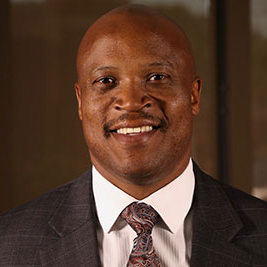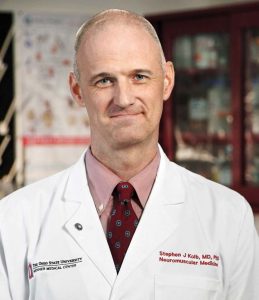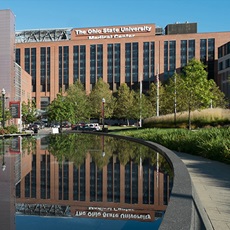Radicava Hopes, Expectations from NFL’s William White and Doctors at Ohio State

William White during his football days at Ohio State. (Photo courtesy of Ohio State and William White)
William White, who entered Ohio State University on a football scholarship, played for the Buckeyes and earned an engineering degree before going on to an 11-year NFL career with the Detroit Lions, the Kansas City Chiefs, and the Atlanta Falcons.
Now retired from the NFL and recently diagnosed with amyotrophic lateral sclerosis (ALS), White has returned to his alma mater to become one of the first Americans set to receive Radicava (edaravone). In May, Radicava was approved by the U.S. Food and Drug Administration (FDA) as the first new therapy to treat ALS symptoms in 22 years.
“Right now, there’s no cure for ALS, but they say that with this drug, if you’ve been diagnosed early, that it can slow it down some,” White said in a phone interview with ALS News Today from his Ohio home. “I’m totally in on that. I’m staying positive that something like that can happen.”
White, 51, said he first realized something was seriously wrong when he went in for a physical late last year, and his doctor noticed twitching in his arms.
“He had me go see Dr. [Kevin] Weber, the neurologist at Ohio State,” White said. “He took me through a bunch of exams, X-rays, MRIs and stuff like that. I think it was around the end of October, first of November, when they diagnosed me with the disease. Then he took me over to see Dr. [Adam] Quick.”
White joins a growing list of retired professional athletes to develop ALS or other neurological disorders. Also known as Lou Gehrig’s disease after the New York Yankees baseball legend who died in 1941, ALS affects about 20,000 Americans at any given time. According to the ALS Association, just over 6,000 people in the United States are diagnosed with the disease each year, most of them between the ages of 40 and 70.
Radicava ‘here and available right now’
Quick and his colleague, Dr. Stephen J. Kolb, are neurologists at Ohio State University’s Wexner Medical Center. Both voiced enthusiasm for Radicava’s arrival three months after its FDA approval.
“The drug is here and available right now,” Quick said in a phone interview from his Columbus clinic. “This is the first new medication since the mid-1990s that has shown some ability to slow down progression of the illness. Here at Ohio State, we aim to be at the forefront of medical advances for the ALS patient, so our interest stems from that.”
Quick’s clinic sees 100 to 150 patients with ALS, and he plans to make Radicava available to “anyone who wants it,” he said. The drug, which was developed, tested and first approved in Japan, is being marketed in the United States by Mitsubishi Tanabe Pharma America.
“I don’t have a great sense of how many we’ll ultimately be treating, but essentially 100 percent of my patients have asked about it,” Quick said.
“We’re very excited about the fact that this might be able to slow progression of the disease, but we’re also measured in our expectation of how effective this drug is,” Kolb added. “The data supports the notion that patients who are very early in the disease and have fairly good respiratory function [will benefit], but it does not show that all patients will necessarily respond.”
In this regard, Kolb said Radicava is very similar to Rilutek (riluzole), “which we have been giving now for over 20 years. Our expectation is not that patients will become stronger, but that it will slow the rate of progression.”
Kolb: ‘New era for therapies’
Radicava, a so-called “free radical scavenger,” works by removing free radicals from the nervous system that cause oxidative stress. It is administered in 28-day cycles via intravenous infusions that are given daily for two weeks, followed by two weeks of rest. In subsequent cycles, patients receive daily infusions for 10 days within a 14-day dosing period, followed by a 14-day drug-free period. At $1,000 per infusion, one year of treatment costs $146,000.
Quick said the infusion itself takes an hour, and “while it’s not as easy as taking a pill,” home infusion companies can offer permanent intravenous access “so that not every patient will have to come into a medical center to get infused.”
In the Japanese Phase 3 clinical study (NCT01492686) upon which the FDA based its approval, patients who received Radicava showed a 33 percent slower decline in ALS progression than those on placebo. But those ALS patients were already on Rilutek, the doctors noted. The idea is that U.S. patients will continue taking Rilutek — which is considered standard of care — as well as Radicava as an additive therapy.
“ALS patients are a pretty savvy group of people, and they understand the risks and benefits of different treatments,” Quick said. “One of my patients who is relatively late in the course of the disease declined this partly because it’s an IV treatment taken daily for two weeks. But I’m anticipating that for people who are motivated to use it, this won’t be such a big burden once it’s up and running.”
Kolb says Radicava’s approval “heralds a new era for therapies” to treat ALS and similar diseases.
“Twenty years ago, they had no medicines for multiple sclerosis. Now there are quite a handful of immune modulatory medications that have efficacy to varying degrees,” he said. “This is just the beginning of what will probably be a larger number of drugs for people with ALS.”
Wexner Medical Center and Answer ALS initiative
White, whose Radicava treatments will begin next month, is one of about 1,000 patients participating in Answer ALS — billed as “the single largest coordinated ALS research effort in history.”
Spearheaded by fellow NFL player Steve Gleason — a former New Orleans Saints safety living with ALS for the past six years — the effort’s mission is “to build the most comprehensive clinical, genetic, molecular and biochemical assessment of ALS and make the data and research tools freely available to ultimately help bring an end to this disease.”
Ohio State’s Wexner Medical Center is one of six clinical sites recruiting for Answer ALS, along with Cedars-Sinai Medical Center in Los Angeles; Emory University in Atlanta; Johns Hopkins University in Baltimore; Massachusetts General Hospital in Boston; and Washington University School of Medicine in St. Louis.
“It’s clear that NFL football players have a higher than expected incidence of ALS than the general population. This is also true of people who have served in the U.S. military,” Quick said. “We don’t understand why that is, and we’re actually trying to help figure this out.”
Kolb noted that patients in the Japanese study had very few side effects from taking Radicava, and thought this was key to its approval. “I was surprised at how quickly this was approved. I had expected to see more data prior to [FDA approval],” he said. But in this case, he thought the U.S. regulatory system acted in the best interests of ALS patients.
“I feel very confident this is a safe drug — and the fact there is some efficacy based on the data that exists,” Kolb said, noting that Radicava’s most common side effects are headaches, bruising, and gait problems. “Going forward, we will be able to define exactly how effective this is. I would rather see how effective it is in the real world as we get it to patients, than wait for a couple more years.”
Adjusting to life with ALS
For now, White said his ALS symptoms haven’t affected his life much, other than the twitching.
“Overall, I’ve kind of changed my diet a little bit, work out a little bit more — but the real bad, bad stuff, I haven’t started into that,” he said. “The twitching and muscle flexes, that’s something you can’t control.”
White, who’s now on the board of directors of Trazer — an Ohio-based company that offers specialized, interactive testing and training programs for concussion management, orthopedic rehabilitation, and sports injury prevention — said he’ll have to adjust his busy schedule to Radicava’s complex infusion routine.
“You get injections for 14 days, then you take 14 days off, then return for 14 more days of injections,” he said. “I travel some, so I’ll have to arrange my travel schedule a bit, or arrange to travel for two weeks at a time.”
Asked if he blames his ALS on a lifetime of professional sports, White said he isn’t sure.
“It may have something to do with it. You never know,” he told us. “In central Ohio, there are 70 people that are part of this [research] program, and I’m the only one who played football. So, one out of 70? There’s a lot of people who have ALS and they did not play football in the NFL.”










